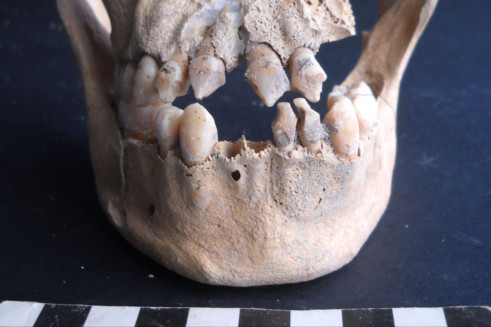
Researchers have analysed the DNA of ancient teeth to identify the regional origin of three African slaves buried more than 300 years ago on a former Dutch colony in the Caribbean.
The development could open the door to broadening the understanding of African American ancestry linked to the European trade in slaves, which often is limited by scant historical record keeping and incomplete genome and population data, according to the study, published online in the journal “Proceedings of the National Academy of Sciences”.
“I like to think of DNA as another type of archive, another type of record that we can use in order to understand the past,” said the study’s lead author, Hannes Schroeder, an archaeologist who studies ancient DNA at the Natural History Museum of Denmark.
When they were unearthed accidentally in 2010 during the construction of an office complex, the three skeletons in the Zoutsteeg area of Philipsburg, on the Dutch side of St Martin, offered strong clues that they had not been born there. Paramount among them were front teeth that had been chipped and filed in patterns that were significant to African tribal cultures, a practice that was largely abandoned after enslavement, Schroeder said.
The dental patterns, however, were not enough to determine where the three likely came from in Africa.
The two men and one woman, ages 25 to 40, probably died between 1660 and 1680, when St Martin was ruled by the French and Dutch. Although archives of the slave trade have expanded greatly, they mention only one docking at St Martin in the last half of the 17th century, and do not list even the port of embarkation, let alone the origin of the slaves themselves.
“There is a lot of information in there, but when it comes to trying to pinpoint ethnic origins, there are no records telling you where a particular individual comes from,” Schroeder said.
Since the publication five years ago of the first ancient genome, researchers have begun shifting focus to relatively recent DNA in areas where little data has been published, including Africa and the Americas.
Carlos Bustamante, a geneticist at Stanford University, has pioneered a method to extract workable DNA from highly damaged and contaminated samples, and has mapped out the overlay between geography and genome characteristics. A recently published Mexican genome study, for example, shows that mixed-heritage or mestizo DNA strongly reflects the population patterns of pre-conquest Mexico — DNA, in a sense, maps out the structure of the pre-Colombian world.
Bustamante and Schroeder used a similar approach to isolate and sequence relatively short strands (67 base pairs) of DNA extracted from the dental roots of the Zoutsteeg Three. The researchers then compared sets of distinguishing characteristics from each individual’s genome with those from 11 West African populations.
“It’s similar to when you have a small trace amount of an element, you can test it because it’s so unique,” Bustamante said. “These DNA markers become like trace elements, that when compounded, give us a lot of evidence.”
One man and the woman probably came from non-Bantu tribes in present-day Nigeria and Ghana, the study found. The other man may have hailed from northern Cameroon, researchers concluded.
Elements of the Cameroon man’s DNA appeared so atypical, in fact, that researchers at first suspected they were looking instead at accidental contamination from modern European DNA. But a reverse migration from Europe to Africa several thousand years ago spread that set of “European” genetic variations across many African populations, Bustamante explained. The so-called haplotype is highly represented in the Lake Chad basin, and rises to 95 per cent in one area of northern Cameroon, according to the study.
The methods used in the study are relatively new, and differ from many commercially available DNA ancestry studies, which often focus on markers from one parent or a single chromosome. As a result, such ancestry data can gloss over many generations of genetic mixing.
Sequencing using partial strands and limited markers, however, has its own limits, and its accuracy depends on the quality and number of the reference panels used for comparison.
Schroeder said the techniques used for the Zoutsteeg Three could be applied to other remains, including those found in New York in the 1990s, and those in cemeteries on the Caribbean island of Guadalupe and the Atlantic island of St Helena.
Bustamante said the technique also shows that viable DNA can be recovered from overlooked areas. Most ancient DNA has come from frozen samples, such as Otzi, the 5,300-year-old mummy found in an Alpine glacier in 1991.
“We’re demonstrating that we can get DNA out of tropical material,” Bustamante said. “St Martins is the very opposite of cold and dry. It is very wet and tropical.”
–Los Angeles Times













